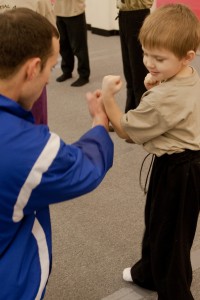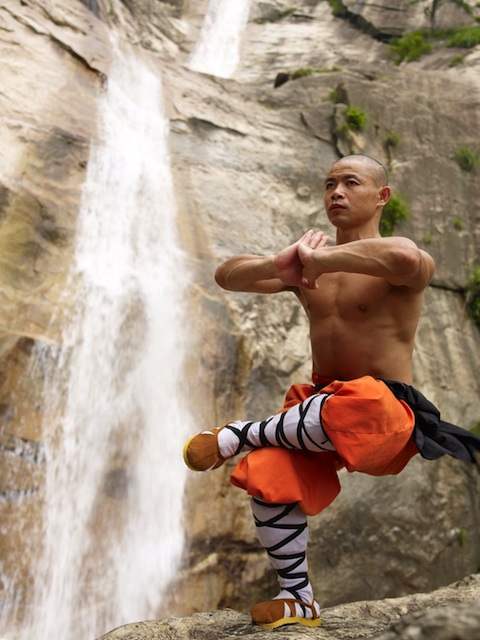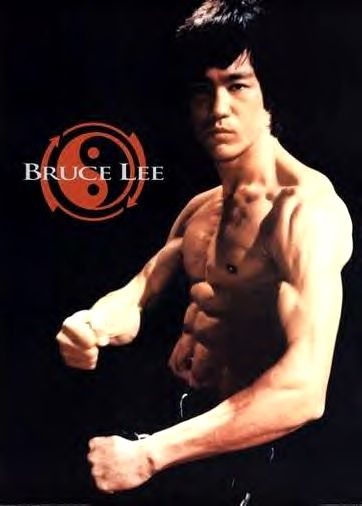I first met Scott when I began training with Shifu Jiang Jianye about 14 years ago. Every time I'd come home and visit the school, Scott was there- still training. Its very hard to find such dedicated students. Maybe its because its hard to find the right teachers. Either way, I wanted to know more about Scott myself and let him share with you his experience, and lessons learned in his many years of training.
When did you initially get involved in martial arts? Chinese Martial Arts?
I come from a military family and am very much an army brat. When I was 5 I lived in Virginia and my father was frequently in Texas for long tours of duty. With no man in the house, my mother wanted me to have male role models and enrolled me in a Karate class. My earliest martial arts memories are of my instructor standing on my knees while I did the butterfly stretch and a man bleeding copious amounts of blood after getting cut on the face during a sparring match.
I didn’t get involved in Chinese Martial Arts until 1998 when I started taking classes with Shifu Jiang. My first competition was a year later at the 1st New England Chinese Martial Arts Championship. I placed in several events and notably got 1st in continuous light contact sparring. The event definitely got me hooked for more training and competition.
What drew you to Kungfu?
After graduating from Hartwick College I was looking for a formal place to study martial arts; not just a club or loose group of friends, which is usually what you got on campus. I was leaning toward Kungfu rather than other martial arts because I felt it matched my physical abilities and temperament best. Other styles seemed either too rigid (Karate), limited in scope (Judo-no striking), or expensive (Tae Kwon Do). Accompanying this was an obsession with Jackie Chan movies at the time. The school was also close to where I lived, worked, and went to grad school. All these things came together to make my choice of Kungfu at this school inevitable.
At what point did you realize Kungfu was something you wanted to make a serious priority in your life?
Before taking Kungfu classes, fitness and martial arts were already a priority. I ran 3 miles regularly and was in a martial arts club in college. When looking for a school to join I had every intention of making a serious commitment. After the first few weeks of class I knew I was in the right place. The schedule fit mine, the people were friendly, and the price was right. Within the first two months I had learned basic staff, broadsword, and an intermediate Shaolin form. I excelled and it’s easy to stick with something when you have success. As I learned more about Kungfu, competed, and watched increasing numbers of Kungfu movies I got even more into it.
What are a few of the main things you have taken away from your time training?
When I first started training I was fully aware that I was already in my physical prime and had to train hard to get myself up to a competitive level. I developed a realization within the first year that the full expanse of Chinese martial arts went beyond just Kungfu forms and movies. Learning Kungfu and Chinese martial arts wasn’t something that would stop when I reached a certain age. Anyone that has trained with Grandmaster Jiang learns that winning competitions and perfecting outrageous acrobatics isn’t the point of training in Chinese martial arts. Chinese martial arts are as much about training to stay healthy as they are for self defense.
Something else I’ve learned from training is goal setting. Before training you need a purpose. Why are you training? I feel many people make the mistake of training just to train or to “get fit.” What does being “fit” mean? Training works best when you have specific, realistic, and trackable goals. Most often this requires something quantifiable, not just “go to the gym twice a week.” The goals need to be broken down. Start large and then go small. Kungfu gives you some of that goal setting. You start with movements, put them together to complete a form, and then move onto a sash test. Completing the sash test or preparing a form for competition is a good long term goal. There are multiple small things that need to be done to meet that goal besides just showing up to class a few times a week.
As a wrestling coach, has your knowledge and training in western wrestling helped you in your Kungfu training?
In wrestling there is a term called “mat sense.” Basically, it’s how well you know where you and all your parts are on the mat in relation to your opponent. Getting and training this sense is vital. Ways this is trained include rolls and cartwheels, both of which you do in wrestling and Kungfu practice. One reason I credit being able to transition well to Kungfu is having some mat sense from my wrestling background.
Another carry-over is knowing how your whole body works. Both wrestling and Kungfu utilize a large number of muscle groups. You must train every part of your body and understand how every part works together to move on as a practitioner. Knowing how far to push your body and how to care for injuries is something you learn over time. I already knew some of my strengths and weaknesses from my experience as a wrestler.
Also, I think my Kungfu training has helped me with coaching as much as my coaching has helped my Kungfu. In Kungfu class you teach once the next person newer than you comes in. Teaching in Kungfu class lifted my teaching confidence and ability in general. I’m an eighth grade science teacher as well as coach. I had been taking Kungfu for over 4 years when I began applying for a teaching position and had a page in my portfolio about teaching Kungfu. It was an easy transition to then begin coaching wrestling with my experience with training kids (and adults) in Kungfu class.
As a teacher, coach, husband and father of two, how have you adapted to keep Kungfu a part of your life?
Everybody is busy and everybody sets priorities; whether it’s done consciously or not. I have placed my health as one of my top priorities. When I was in my teens I noticed a great many men who were beer-bellied and unable to touch their toes. I vowed at that time to always remain active and be healthy. I have adopted Shifu Jiang’s philosophy of having quality of life as you age, and he is the best example of this. He is a real inspiration. I still want to be able to touch my toes the day I die, whenever that may be.
Having consistency in the class schedule helps too. The classes have always been Saturday 12pm to 3pm and Wednesday 8pm to 10pm. That consistency has enabled me to set my schedule for the last 13 years. Many things have come and gone in my life, but those two classes are still around. I’ve just always had class those nights and habit is one of the best ways to maintain fitness and practice. Consistency. If I had a job that didn’t allow me to go to class Saturday and Wednesday I think I’d…no…wait…I would never have taken that job.
What does your family think of it?
My family has only known me as a martial artist. It’s just part of who I am. My wife and kids enjoy watching me do events like Chinese New Year celebrations and other events.
Would you like to see your children involved in Chinese Martial Arts?
It’s great to be able to share things with your children. My wife and I enrolled both our daughters in gymnastics once they were old enough. I’ve started my youngest in the Kids Kungfu program at CMAA. The kids Kungfu program at CMAA is essential to the promotion of the art in the Capitol Region. I’m happy to have my youngest going to the Saturday class. We’ll see if she sticks with it in the long run. My mom is starting Tai Chi as well which is exciting for both of us.
What advice would you give to others as far as training with weights, food supplements, etc.?
Done improperly both supplements and weight training can reduce performance and increase chances of injury. Both can also provide potential benefits, particularly weight training. Weight training should be done with specific goals in mind for the sport being undertaken. Dead lifts are a perfect weight training example of something that can be done wrong. Many athletes, particularly if they are young and inexperienced, can get up to a great deal of weight and feel very confident in their perceived strength. However, they often don’t stretch enough or allow for proper rest. Eventually, they strain or pull muscles in their lower back. I’ve seen it happen numerous times. If you are serious enough about a sport or activity you should be serious enough to get the proper training.
Unless you have been training for years and are already at the top of your game, supplements are not needed. Staying hydrated and eating a well balanced diet are all you need. I am a hockey fan and had the chance to ask some professional players about supplements. They said they didn’t use them. These are professional athletes trying to reach peak performance and they’re not taking supplements. What real benefits would someone at the amateur level have to gain from them? With the long term risks still not known I discourage student-athletes from protein supplements in particular. The mythology around protein and creatine is immense. I have students who can’t even do ten push-ups asking if they should drink protein shakes! I know many weightlifters swear by supplements and protein shakes, but I don’t feel they provide any real benefit to most wrestlers or martial artists.
Is there anyone that you are inspired by or that you look up to in the martial arts community? Looking back all these years, who do you consider as your main coaches or influences?
Grandmaster Jianye Jiang and Master Lu are my primary influences for obvious reasons. I’ve trained with them for 13 years and they are responsible for the martial artist I am today. Grandmaster Jiang has influenced not only my physical but philosophical well being; particularly in terms of wellness and aging. Grandmaster Pan Qing Fu has also been a great influence. The man is a living legend and I am privileged to have done a few seminars with him that made a lasting impression. My other influences are the students in Kungfu class. We really feed off each other and encourage mutual progression. The gains made and the difficulties overcome are truly inspiring. When you have been going to class as long as I have you see students do things they thought they could not like lose 40lbs, attain a jump kick, or do a cartwheel. Truly inspiring things.
If you could give any advice to someone (older or younger) who has a passion for martial arts, what would it be?
Make it more than a hobby. A hobby is something you do on your free time. Being a martial artist goes much deeper. Don’t be afraid to branch out into other martial arts. Be competitive. Always set new goals. Training for the sake of training is pointless. Just like in life, set short and long term goals, when you reach a long term goal, set a new one.
- Thanks for sharing Scott. There are MANY valuable lessons to be learned from your experiences.
Shifu





